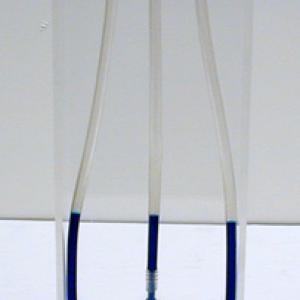College of Liberal Arts & Sciences
2C20.10 - Bernoulli's Principle - Venturi Tubes
The Venturi tube demos may need to have water added to them. A disposable syringe with a long curved or bent needle seems to work the best. Too much air pressure will draw the water up far enough that it will be blown out the other side.
- Paul Hewitt, "Answer to April Figuring Physics", TPT, Vol. 57, #5, May 2019, p. 339.
- Carl E. Mungan, "Pressure Change in an Arterial Constriction", TPT, Vol. 53, #9, Dec. 2015, p. 561.
- Tyler Rohr and Jim Rohr, "Half Empty or Half Full?", TPT, Vol. 53, #5, May 2015, p. 275.
- Thomas B. Greenslade, Jr., "Water Spout", TPT, Vol. 51, #2, Feb. 2103, p. 82.
- Nathaniel R. Greene and Matthew R. Dworsak, "Bernoulli at the Gas Pump", TPT, Vol. 39, #9, Sept. 2001, p. 346.
- Paul Hewitt, "Figuring Physics: Air Bubbles in Water", TPT, Vol. 38, #7, Oct. 2000, p. 394.
- Brian W. Holmes, "My Teacher is a Blowhard", TPT, Vol. 34, #6, Sept. 1996, p. 362.
- Robert P. Bauman, "The Author Replies", TPT, Vol. 33, #6, Sept. 1995, p. 325.
- Bruce D. Bedford, "The Flying Controversy", TPT, Vol. 33, #6, Sept. 1995, p. 324.
- Robert Bauman and Rolf Schawaneberg, "Interpretation of Bernoulli's Equation", TPT, Vol. 32, #8, Nov. 1994, p. 478.
- Henry S. Badeer and Costas E. Synolakis, "The Bernoulli-Poiseuille Equation", TPT, Vol. 27, #8, Nov. 1989, p. 598.
- A. Sieradzan and W. Chaffee, "Bernoulli Revisited: A Simple Demonstration", TPT, Vol. 27, #4, Apr. 1989, p. 306.
- David H. Martin, "The Author Replies", TPT, Vol. 21, # 5, May 1983, p. 282.
- Mario Iona, "Beyond Bernoulli", TPT, Vol. 21, # 5, May 1983, p. 282.
- David H. Martin, "Misunderstanding Bernoulli", TPT, Vol. 21, # 1, Jan. 1983, p. 37.
- Norman F. Smith, "Bernoulli and Newton in Fluid Mechanics", TPT, Vol. 10, #8, Nov. 1972, p. 451.
- Robert P. Bauman, "An Alternative Derivation of Bernoulli's Principle", AJP, Vol. 68, #3, Mar. 2000, p. 288.
- Klaus Weltner, "A Comparison of Explanations of the Aerodynamic Lifting Force", AJP, Vol. 55, #1, Jan. 1987, p. 50.
- R. L. Hartman, "Bernoulli's Law Demonstrator", AJP, Vol. 34, #5, May 1966, p. 445.
- Freier and Anderson, "Fj-1", A Demonstration Handbook for Physics.
- "F-210: Constriction of Air Flow", DICK and RAE Physics Demo Notebook.
- Richard Manliffe Sutton, "M-294", Demonstration Experiments in Physics.
- Jearl Walker, "Why a Fluid Flows Faster When the Tube Is Pinched", The Amateur Scientist, July, 1987.
- Matt Bobrowsky, "Q: Is It Really Caused by the Bernoulli Effect?", Science & Children, Nov./Dec. 2018, www.nsta.org/elementaryschool
- R. W. Pohl, Physical Principles of Mechanics and Acoustics, p. 193.
- Charles Vivian, "How Water Spurts", Science Experiments & Amusements For Children, p. 65.
- Neil A. Downie, "17: Bernoulli's Clock", Vacuum Bazookas, Electric Rainbow Jelly and 27 Other Saturday Science Projects, p. 142.
- John Welch, "Abstract: Pressure in Air Stream", 2005 Apparatus Competition, Salt Lake City, UT.
- W. Bolton, "Bernoulli Effect", Book I - Properties of Materials, Physics Experiments and Projects, 1968, p. 25.
- Julius Sumner Miller, Q108 & A108, Millergrams I – Some Enchanting Questions for Enquiring Minds, p. 69 & 116.
Disclaimer: These demonstrations are provided only for illustrative use by persons affiliated with The University of Iowa and only under the direction of a trained instructor or physicist. The University of Iowa is not responsible for demonstrations performed by those using their own equipment or who choose to use this reference material for their own purpose. The demonstrations included here are within the public domain and can be found in materials contained in libraries, bookstores, and through electronic sources. Performing all or any portion of any of these demonstrations, with or without revisions not depicted here entails inherent risks. These risks include, without limitation, bodily injury (and possibly death), including risks to health that may be temporary or permanent and that may exacerbate a pre-existing medical condition; and property loss or damage. Anyone performing any part of these demonstrations, even with revisions, knowingly and voluntarily assumes all risks associated with them.
